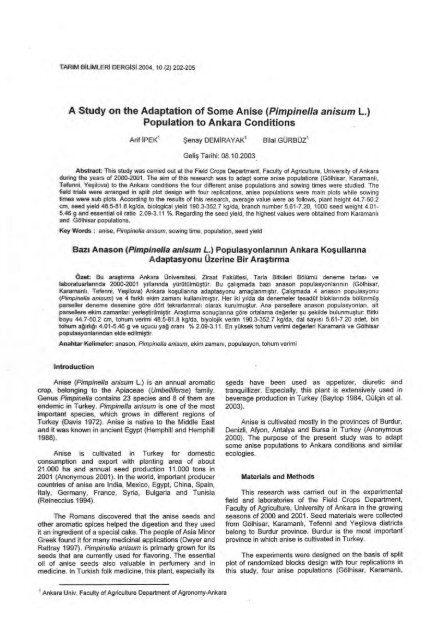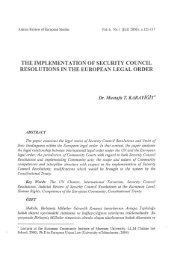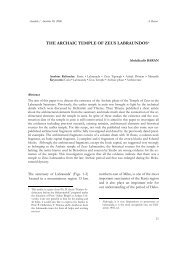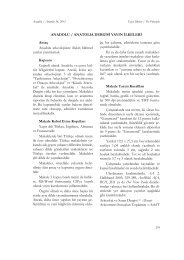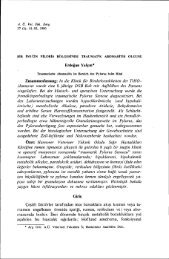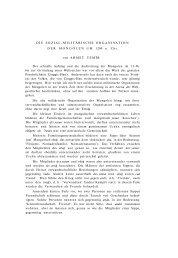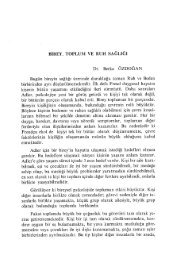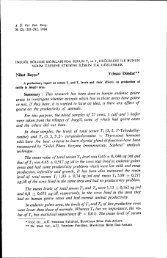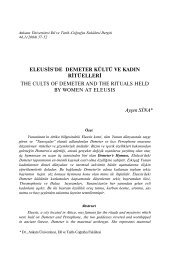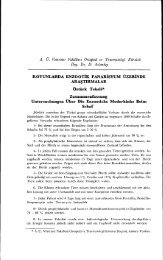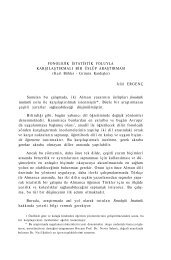A Study on the Adaptation of Some Anise (Pimpinella anisum L ...
A Study on the Adaptation of Some Anise (Pimpinella anisum L ...
A Study on the Adaptation of Some Anise (Pimpinella anisum L ...
Create successful ePaper yourself
Turn your PDF publications into a flip-book with our unique Google optimized e-Paper software.
TARIM BILIMLERI DERGISI 2004, 10 (2) 202-205<br />
A <str<strong>on</strong>g>Study</str<strong>on</strong>g> <strong>on</strong> <strong>the</strong> Adaptati<strong>on</strong> <strong>of</strong> <strong>Some</strong> <strong>Anise</strong> (<strong>Pimpinella</strong> <strong>anisum</strong> L.)<br />
Populati<strong>on</strong> to Ankara C<strong>on</strong>diti<strong>on</strong>s<br />
Arif IPEK' Şenay DEM İ RAYAK 1 Bilal GÜRBÜZ'<br />
Geli ş Tarihi: 08.10.2003 .<br />
Abstract: This study was carried out at <strong>the</strong> Field Crops Department, Faculty <strong>of</strong> Agriculture, University <strong>of</strong> Ankara<br />
during <strong>the</strong> years <strong>of</strong> 2000-2001. The aim <strong>of</strong> this research was to adapt some anise populati<strong>on</strong>s (Gölhisar, Karamanl ı ,<br />
Tefenni, Ye şilova) to <strong>the</strong> Ankara c<strong>on</strong>diti<strong>on</strong>s <strong>the</strong> four different anise populati<strong>on</strong>s and sowing times were studied. The<br />
field trials were arranged in split plot design with four replicati<strong>on</strong>s, anise populati<strong>on</strong>s were main plots while sowing<br />
times were sub plots. According to <strong>the</strong> results <strong>of</strong> this research, average value were as follows, plant height 44.7-50.2<br />
cm, seed yield 48.5-81.8 kg/da, biological yield 190.3-352.7 kg/da, branch number 5.61-7.20, 1000 seed weight 4.01-<br />
5.46 g and essential oil ratio 2.09-3.11 %. Regarding <strong>the</strong> seed yield, <strong>the</strong> highest values were obtained from Karamanl ı<br />
and Gölhisar populati<strong>on</strong>s.<br />
Key Words : anise, <strong>Pimpinella</strong> <strong>anisum</strong>, sowing time, populati<strong>on</strong>, seed yield<br />
Baz ı Anas<strong>on</strong> (<strong>Pimpinella</strong> <strong>anisum</strong> L.) Populasy<strong>on</strong>lar ı n ı n Ankara Koşullar ı na<br />
Adaptasy<strong>on</strong>u Üzerine Bir Ara şt ı rma<br />
Özet: Bu ara şt ı rma Ankara Üniversitesi, Ziraat Fakültesi, Tarla Bitkileri Bölümü deneme tarlas ı ve<br />
laboratuarlar ı nda 2000-2001 y ı llar ı nda yürütülmü ştür. Bu çal ışmada baz ı anas<strong>on</strong> populasy<strong>on</strong>lar ı n ı n (Gölhisar,<br />
Karamanl ı , Tefenni, Yeşilova) Ankara ko ş ullar ı na adaptasy<strong>on</strong>u amaçlanm ışt ı r. Çal ışmada 4 anas<strong>on</strong> populasy<strong>on</strong>u<br />
(<strong>Pimpinella</strong> <strong>anisum</strong>) ve 4 farkl ı ekim zaman ı kullan ı lm ışt ı r. Her iki y ı lda da denemeler tesadüf bloklar ı nda bölünmü ş<br />
parseller deneme desenine göre dört tekrarlanmal ı olarak kurulmu ştur. Ana parsellere anas<strong>on</strong> populasy<strong>on</strong>lar ı , alt<br />
parsellere ekim zamanlar ı yerle ştirilmi ştir. Ara ştı rma s<strong>on</strong>uçlar ı na göre ortalama de ğerler ş u şekilde bulunmu ştur: Bitki<br />
boyu 44.7-50.2 cm, tohum verimi 48.5-81.8 kg/da, biyolojik verim 190.3-352.7 kg/da, dal say ı s ı 5.61-7.20 adet, bin<br />
tohum a ğı rl ığı 4.01-5.46 g ve uçucu ya ğ oran ı % 2.09-3.11. En yüksek tohum verimi de ğ erleri Karamanl ı ve Gölhisar<br />
populasy<strong>on</strong>lar ı ndan elde edilmi ştir.<br />
Anahtar Kelimeler: anas<strong>on</strong>, <strong>Pimpinella</strong> <strong>anisum</strong>, ekim zaman ı , populasy<strong>on</strong>, tohum verimi<br />
Introducti<strong>on</strong><br />
<strong>Anise</strong> (<strong>Pimpinella</strong> <strong>anisum</strong> L.) is an annual aromatic<br />
crop, bel<strong>on</strong>ging to <strong>the</strong> Apiaceae (Umbelliferae) family.<br />
Genus <strong>Pimpinella</strong> c<strong>on</strong>tains 23 species and 8 <strong>of</strong> <strong>the</strong>m are<br />
endemic in Turkey. <strong>Pimpinella</strong> <strong>anisum</strong> is <strong>on</strong>e <strong>of</strong> <strong>the</strong> most<br />
important species, which grows in different regi<strong>on</strong>s <strong>of</strong><br />
Turkey (Davis 1972). <strong>Anise</strong> is native to <strong>the</strong> Middle East<br />
and it was known in ancient Egypt (Hemphill and Hemphill<br />
1988).<br />
<strong>Anise</strong> is cultivated in Turkey for domestic<br />
c<strong>on</strong>sumpti<strong>on</strong> and export with planting area <strong>of</strong> about<br />
21.000 ha and annual seed producti<strong>on</strong> 11.000 t<strong>on</strong>s in<br />
2001 (An<strong>on</strong>ymous 2001). In <strong>the</strong> world, important producer<br />
countries <strong>of</strong> anise are India, Mexico, Egypt, China, Spain,<br />
Italy, Germany, France, Syria, Bulgaria and Tunisia<br />
(Reineccius 1994).<br />
The Romans discovered that <strong>the</strong> anise seeds and<br />
o<strong>the</strong>r aromatic spices helped <strong>the</strong> digesti<strong>on</strong> and <strong>the</strong>y used<br />
it an ingredient <strong>of</strong> a special cake. The people <strong>of</strong> Asia Minor<br />
Greek found it for many medicinal applicati<strong>on</strong>s (Owyer and<br />
Rattray 1997). <strong>Pimpinella</strong> <strong>anisum</strong> is primarly grown for its<br />
seeds that are currently used for flavoring. The essential<br />
oil <strong>of</strong> anise seeds also valuable in perfumery and in<br />
medicine. In Turkish folk medicine, this plant, especially its<br />
I Ankara Univ. Faculty <strong>of</strong> Agriculture Department <strong>of</strong> Agr<strong>on</strong>omy -Ankara<br />
seeds have been used as appetizer, diuretic and<br />
tranquillizer. Especially, this plant is extensively used in<br />
beverage producti<strong>on</strong> in Turkey (Baytop 1984, Gülçin et al.<br />
2003).<br />
<strong>Anise</strong> is cultivated mostly in <strong>the</strong> provinces <strong>of</strong> Burdur,<br />
Denizli, Afy<strong>on</strong>, Antalya and Bursa in Turkey (An<strong>on</strong>ymous<br />
2000). The purpose <strong>of</strong> <strong>the</strong> present study was to adapt<br />
some anise populati<strong>on</strong>s to Ankara c<strong>on</strong>diti<strong>on</strong>s and similar<br />
ecologies.<br />
Materials and Methods<br />
This research was carried out in <strong>the</strong> experimental<br />
field and laboratories <strong>of</strong> <strong>the</strong> Field Crops Department,<br />
Faculty <strong>of</strong> Agriculture, University <strong>of</strong> Ankara in <strong>the</strong> growing<br />
seas<strong>on</strong>s <strong>of</strong> 2000 and 2001. Seed materials were collected<br />
fı-om Gölhisar, Karamanl ı , Tefenni and Ye şilova districts<br />
bel<strong>on</strong>g to Burdur province. Burdur is <strong>the</strong> most important'<br />
province in which anise is cultivated in Turkey.<br />
The experiments were designed <strong>on</strong> <strong>the</strong> basis <strong>of</strong> split<br />
plot <strong>of</strong> randomized blocks design with four replicati<strong>on</strong>s in<br />
this study, four anise populati<strong>on</strong>s (Gölhisar, Karamanl ı ,
İ PEK, A., Ş . DEM İRAYAK and B. GÜRBÜZ, study <strong>on</strong> <strong>the</strong> adaptati<strong>on</strong> <strong>of</strong> some anise (<strong>Pimpinella</strong> <strong>anisum</strong> L.) 203<br />
populati<strong>on</strong> to Ankara c<strong>on</strong>diti<strong>on</strong>s"<br />
Tefenni and Yeşilova) and four different sowing times<br />
were used as experimental factors. Sowing times were<br />
arranged at intervals <strong>of</strong> two weeks and first sowing was<br />
performed at <strong>the</strong> beginning <strong>of</strong> March. Experiments were<br />
watered two times in both years but no fertilizer was<br />
applied. Planting rate was 2 kg/da. Each populati<strong>on</strong>s were<br />
planted in a fıve-row plot that was 3 m l<strong>on</strong>g with 30 cm<br />
between rows. At <strong>the</strong> harvesting time, <strong>the</strong> following traits<br />
were observed: plant height, seed yield, biological yield,<br />
branch number, 1000 seed weight and essential oil ratio.<br />
Essential oil c<strong>on</strong>tent was determined by using <strong>the</strong> water<br />
distillati<strong>on</strong> method. Ali results by characters were<br />
subjected to analysis <strong>of</strong> variance and Duncan's Multiple<br />
Range Test was performed in order to find differences<br />
am<strong>on</strong>g <strong>the</strong> factors (Yurtsever 1984).<br />
Results and Discussi<strong>on</strong><br />
The results <strong>of</strong> plant height, seed yield, biological<br />
yield, branch number, 1000 seed weight and essential oil<br />
ratio were presented in Table 1 and Table 2.<br />
Plant height: The average plant height values<br />
ranged between 44.7-50.2 cm. The highest value was<br />
measured in combinati<strong>on</strong> <strong>of</strong> ST1 x P4 while <strong>the</strong> lowest was<br />
ST4 x P4 (Table 1). There was no significant difference<br />
am<strong>on</strong>g average sowing times and populati<strong>on</strong>s. However,<br />
<strong>the</strong> maximum plant height was recorded in first sowing<br />
time (49.3 cm) and in both populati<strong>on</strong>s <strong>of</strong> Gölhisar and<br />
Karamanl ı . Hemphill and Hemphill (1988) and Dwyer and<br />
Rattray (1997), reported similar data as between 45-60 cm<br />
and 30-60 cm, respectively.<br />
Table 1. Comparis<strong>on</strong> <strong>of</strong> plant height, seed yield and biological yield values<br />
Seed yield: There were significant differences<br />
am<strong>on</strong>g <strong>the</strong> seed yields <strong>of</strong> populati<strong>on</strong>s and sowing times.<br />
Also an interacti<strong>on</strong> between two factors was statically<br />
important. Regarding interacti<strong>on</strong>, <strong>the</strong> highest value with<br />
81.8 kg/da was obtained in ST İ x P2 combinati<strong>on</strong> whereas<br />
<strong>the</strong> lowest seed yield was in ST4 x P3 (48.5 kg/da) (Table<br />
1). The nine different groups were obtained statically.<br />
Seed yield values varied between 52.9 kg/da (ST4) and<br />
72.1 kg/da (ST1) in sowing times while it was changed<br />
between 56.3 kg/da (P3) and 67.4 kg/da (P2) in<br />
populati<strong>on</strong>s. The results showed that delaying <strong>the</strong> sowing<br />
time decreased <strong>the</strong> seed yield. The results showed<br />
similarities with <strong>the</strong> data <strong>of</strong> Maheshwari et al. (1984) and<br />
Gangrade et al. (1989), reported 50.1 kg/da and 80.4<br />
kg/da seed yield, respectively.<br />
Biological yield: The average biological yield<br />
changed between 190.3-352.7 kg/da (Table 1). The<br />
highest value was in ST1 x P4 and <strong>the</strong> lowest was in ST4 x<br />
There was <strong>on</strong>ly significant differenc: am<strong>on</strong>g <strong>the</strong><br />
sowing times. Maximum biological yield was determined in<br />
<strong>the</strong> first sowing time with 342.5 kg/da whereas <strong>the</strong><br />
minimum value was recorded in <strong>the</strong> fourth sowing time<br />
with 201.5 kg/da. There was no significant difference<br />
am<strong>on</strong>g <strong>the</strong> populati<strong>on</strong>s. Arslan et al. (1999) reported <strong>the</strong><br />
average values <strong>of</strong> 169.8-237.5 kg/da lower than our data.<br />
Branch number: The highest branch number with<br />
7.20 was measured in <strong>the</strong> combinati<strong>on</strong> <strong>of</strong> ST4 x P2 while<br />
<strong>the</strong> lowest value was 5.61 in ST2 x P4 (Table 2). Significant<br />
differences were observed in terms <strong>of</strong> branch number<br />
am<strong>on</strong>g <strong>the</strong> sowing times and three groups were formed.<br />
Sowing time x Plant height (cm) Seed yield (kg/da) Biological yield (kg/da)<br />
populati<strong>on</strong> 2000 2001 average 2000 2001 average 2000 2001 average<br />
P, 51.2 47.7 49.5 71.3 61.6 66.4 cde** 350.6 317.6 334.1<br />
ST İ * P2 51.5 46.5 49.0 87.0 76.5 81.8 a 345.6 341.8 343.7<br />
P3 51.5 46.0 48.7 72.0 66.5 69.3 bcd 334.4 344.6 339.5<br />
P4 52.7 47.5 50.2 80.7 61.5 71.1 bcd 315.0 390.4 352.7<br />
P, 50.7 43.1 46.9 96.7 56.0 76.3 ab 296.7 250.1 273.4<br />
ST2 P2 51.7 44.9 48.3 78.7 66.2 72.4 bc 253.3 250.1 251.7<br />
P3 52.2 41.2 47.0 63.3 51.2 57.3 fgh 257.2 230.0 243.6<br />
P4 52.7 39.7 46.2 75.3 51.1 63.3 def 248.3 235.1 241.7<br />
P, 50.7 46.2 48.5 65.3 52.2 58.7 efgh 258.9 205.3 232.1<br />
ST3 P2 50.7 46.8 48.8 68.3 52.2 60.3 efg 271.1 235.7 253.4<br />
P3 50.5 46.1 48.3 58.0 42.2 50.1 hl 243.9 283.7 263.8<br />
P4 52.2 43.9 48.1 48.8 62.1 55.5 fghl 253.9 241.7 247.8<br />
P, 48.7 46.4 47.6 59.7 52.0 55.9 fghl 190.6 190.0 190.3<br />
ST4 P2 49.2 43.7 46.5 63.3 47.1 55.2 fghl 218.3 210.1 214.2<br />
P3 49.5 43.3 4'6.4 50.1 47.0 48.51 200.6 200.0 200.3<br />
P4 48.5 41.0 44.7 58.1 46.0 52.0 ghl 201.1 201.1 201.1<br />
Average <strong>of</strong> ST İ 51.7 46.9 49.3 77.8 66.5 72.1 a 336.4 348.6 342.5 a<br />
sowing times ST2<br />
ST3<br />
51.9<br />
51.1<br />
42.4<br />
45.8<br />
47.1<br />
48.4<br />
78.5<br />
60.1<br />
56.2<br />
52.2<br />
67.3 a<br />
56.1 b<br />
263.9<br />
256.9<br />
241.3<br />
241.7 -<br />
252.6 b<br />
249.3 b<br />
ST4 49.0 43.6 46.3 57.8 48.0 52.9 b 202.6 200.4 201.5 b<br />
Average <strong>of</strong><br />
populati<strong>on</strong><br />
P,<br />
P2<br />
P3<br />
50.4<br />
50.8<br />
50.9<br />
45.9<br />
45.5<br />
44.3<br />
48.1<br />
48.1<br />
47.6<br />
73.3<br />
74.3<br />
60.9<br />
55.4<br />
60.5<br />
51.7<br />
64.3 a<br />
67.4 a<br />
56.3 c<br />
274.2<br />
272.1<br />
259.0<br />
240.6<br />
257.2<br />
264.6<br />
257.4<br />
265.7<br />
261.8<br />
P4 51.6 43.1 47.3 65.7 55.2 60.5 b 254.6 267.0 260.8<br />
* ST: Sowing time, P,: Gölhisar, P2: Karamanl ı , P3: Tefenni, P4: Yeşilova<br />
** Mean value followed by <strong>the</strong> difference letters are significant at <strong>the</strong> 0.05 level
204 TARIM B İ L İMLER İ DERGISI 2004, Cilt 10, Say ı 2<br />
Table 2. Comparis<strong>on</strong> <strong>of</strong> branch number, 1000 seed weight and essential oil ratio values<br />
Sowing time x Branch number 1000 seed weight (g) Essential oil ratio (%)<br />
populati<strong>on</strong> 2000 2001 average 2000 2001 average 2000 2001 average<br />
P, 6.00 7.04 6.52 5.03 4.89 4.96 a 2.33 2.47 2.40<br />
ST,* P2 5.75 6.69 6.22 5.56 5.30 5.43 a 2.53 2.51 2.52<br />
P3 5.25 7.25 6.25 5.62 5.30 5.46 a 2.65 2.63 2.64<br />
P4 6.50 6.50 6.50 5.50 4.50 5.00 b 2.83 2.71 2.77<br />
P ı 6.25 5.57 5.91 4.75 3.99 4.37 cd 3.20 2.18 2.69<br />
ST2 P2 6.50 6.22 6.36 4.96 4.20 4.58 c 3.78 2.44 3.11<br />
P3 6.25 6.71 6.48 4.81 3.99 4.40 cd 3.75 2.17 2.96<br />
P4 6.25 4.97 5.61 4.75 4.21 4.48 c 3.68 2.52 3.10<br />
P, 7.00 7.10 7.05 5.01 3.79 4.40 cd 3.08 2.50 2.79<br />
ST3 P2 6.50 6.40 6.45 4.68 4.00 4.34 cde 3.58 2.44 3.01<br />
P3 6.00 6.68 6.34 4.71 3.59 4.15 def 3.10 2.54 2.82<br />
P4 6.50 6.50 6.50 4.22 3.80 4.01 f 3.75 2.35 3.05<br />
P, 7.50 6.64 7.07 4.87 3.69 4.28 cdef 2.08 2.10 2.09<br />
ST4 P2 7.50 6.90 7.20 4.80 4.06 4.43 cd 2.55 2.09 2.32<br />
P3 7.75 6.09 6.92 4.43 3.69 4.06 ef 2.10 2.70 2.40<br />
P4 6.75 6.79 6.77 4.96 3.60 4.28 cdef 2.40 2.12 2.26<br />
Average <strong>of</strong> 1 5.88 6.86 637bc** 5.43 4.99 5.21 a 2.58 2.58 2.58 b<br />
sowing 2 6.31 5.87 6.09 c 4.82 4.10 4.46 b 3.60 2.34 2.97 a<br />
times 3 6.50 6.66 6.58 ab 4.65 3.81 4.23 b 3.38 2.46 2.92 a<br />
4 7.38 6.66 6.99 a 4.76 3.76 4.26 b 2.28 2.26 2.27 c<br />
Average <strong>of</strong> 1 6.69 5.59 6.64 4.91 4.11 4.51 b 2.67 2.31 2.49 b<br />
populati<strong>on</strong> 2 6.56 6.56 6.56 5.00 4.38 4.69 a 3.11 2.37 2.74 a<br />
3 6.31 6.69 6.50 4.89 4.15 4.52 b 2.90 2.51 2.71 a<br />
4 6.50 6.20 6.35 4.86 4.02 4.44 b 3.16 2.44 2.80 a<br />
* ST: Sowing time, P,: Gölhisar, P2: Karamanl ı , P3: Tefenni, P4: Yeşilova<br />
"* Mean value followed by <strong>the</strong> difference letters are significant at <strong>the</strong> 0.05 level<br />
However, differences am<strong>on</strong>g <strong>the</strong> populati<strong>on</strong>s values were<br />
low. Our results showed similarities with <strong>the</strong> data <strong>of</strong><br />
Bayram (1992), recorded 6.51-7.90 branch number per<br />
plant.<br />
1000 seed weight: Statistically, <strong>the</strong>re were<br />
significant differences am<strong>on</strong>g <strong>the</strong> sowing times, populati<strong>on</strong><br />
and interacti<strong>on</strong> <strong>of</strong> sowing times x populati<strong>on</strong>s (ST x P).<br />
The average values changed between 4.01-5.46 g. The<br />
maximum data was in ST İ x P3 while <strong>the</strong> minimum value<br />
was in ST3 x P4 (Table 2). First sowing time had <strong>the</strong><br />
highest 1000 seed weight with 5.21 g while populati<strong>on</strong> 2<br />
had <strong>the</strong> highest value with 4.69 g. These results were<br />
higher than <strong>the</strong> data <strong>of</strong> Otan et al. (1991) (3.18-3.75 g)<br />
and Bayram (1992) (2.37-2.65 g).<br />
Essential oil ratio: There were significant difference<br />
am<strong>on</strong>g <strong>the</strong> sowing times and populati<strong>on</strong>s. The interacti<strong>on</strong><br />
between sowing times and populati<strong>on</strong>s was not found<br />
important, statically. Essential oil ratios ranged between<br />
2.09-3.11 %. The highest ratio was recorded in ST2 x P2<br />
when <strong>the</strong> lowest ratio was in ST4 x Pi (Table 2). In sowing<br />
times, it was between 2.27-2.97 % and in populati<strong>on</strong>s, it<br />
was between 2.49-2.80 %. Similarly with our results<br />
Gangrede et al. (1989) reported that essential oil ratio was<br />
higher in earlier sowing. Melchi<strong>on</strong> and Kas<strong>the</strong>r (1974) and<br />
Kevsero ğlu (1982) recorded similar data with 2.3 % and<br />
2.10-2.83 %, respectively.<br />
In c<strong>on</strong>clusi<strong>on</strong>, anise 'is cultivated mostly in <strong>the</strong><br />
provinces <strong>of</strong> Burdur, Denizli, Afy<strong>on</strong>, Antalya and Bursa.<br />
The results <strong>of</strong> this results showed that anise can be<br />
cultivated in Ankara and similar c<strong>on</strong>diti<strong>on</strong>s with irrigati<strong>on</strong><br />
applicati<strong>on</strong>. Average anise seed yield is about 60 kg/da in<br />
Turkey. In this study, especially earlier sowing time, seed<br />
yield was obtained more than average <strong>of</strong> Turkey.<br />
References<br />
An<strong>on</strong>ymous, 2000. Agricultural structure. State Institute <strong>of</strong><br />
Statistics, publicati<strong>on</strong> number 2614, Ankara.<br />
An<strong>on</strong>ymous, 2001. The summary <strong>of</strong> agricultural statistics. State<br />
Institute <strong>of</strong> Statistics, Publicati<strong>on</strong> number 2719, Ankara.<br />
Arslan, N., B. Gürbüz and A. Gümü şçü. 1999. Farkl ı orjinli anas<strong>on</strong><br />
(<strong>Pimpinella</strong> <strong>anisum</strong>) populasy<strong>on</strong>lar ı nda verim ve verim<br />
özelliklerinin ara şt ı r ı lmas ı . Tarla Bitkileri Merkez Ara şt ı rma<br />
Enstitüsü Dergisi, Cilt. 8 (1-2) 52-58, Ankara.<br />
Bayram, E, 1992. Türkiye kültür anas<strong>on</strong>lar ı (<strong>Pimpinella</strong> <strong>anisum</strong>)<br />
üzerinde agr<strong>on</strong>omik ve teknolojik ara şt ı rmalar. Ege Üniv.<br />
Ziraat Fak., Proje No: 88-ZRF-011, İzmir.<br />
Baytop, T. 1984. Türkiye'de Bitkilerle Tedavi. İstanbul Oniv.<br />
Eciac ı l ı k Fak. Yay ı nlar ı No 40, s.520, İstanbul.<br />
Davis, P. H. 1972. Flora <strong>of</strong> Turkey and <strong>the</strong> East Aegean Islands.<br />
Volume 4, Edinburgh University Press, Edinburgh.<br />
Dwyer, J. and D. Rattray, 1997. Magic and Medicine <strong>of</strong> plants.<br />
Reader's Digest General Books, 464 p., New York.<br />
Gangrade, S. K., R. D. Shrivastava, O. P. Sharma, B. G. Iver and<br />
K. C. Trivedi, 1989. Influence <strong>of</strong> micr<strong>on</strong>utrients <strong>on</strong> yield and<br />
quality <strong>of</strong> anise. Indian Perfumer, 33 (3), 169-173.<br />
Gülçin, İ. M. Oktay, E. Kireçci and Ö. İ . Küfrevio ğlu, 2003.<br />
Screening <strong>of</strong> antioxidant and antimicrobial activities <strong>of</strong> anise<br />
(<strong>Pimpinella</strong> <strong>anisum</strong>) seed extracts. Food Chemistry Article<br />
(in press)
İ PEK, A., Ş . DEMIRAYAK and B. GÜRBÜZ, "A study <strong>on</strong> <strong>the</strong> adaptati<strong>on</strong> <strong>of</strong> some anise (<strong>Pimpinella</strong> <strong>anisum</strong> L.) 205<br />
populati<strong>on</strong> to Ankara c<strong>on</strong>diti<strong>on</strong>s"<br />
Hemphill, J. and R. Hemphill, 1988. Herbs, Their Cultivati<strong>on</strong> and<br />
Usage. Blandford Press, p.128, L<strong>on</strong>d<strong>on</strong>.<br />
Kevsero ğ lu, K. 1982. Baz ı anas<strong>on</strong>lar ı n fenolojik, morfolojik ve<br />
kalite özellikleri ile çiçek biyolojisi üzerinde ara şt ı rmalar.<br />
Ankara Üniv. Fen Bilimleri Enstitüsü Doktora Tezi, Ankara.<br />
Maheswari, S. K., R. S. Gupta and S. Yadav, 1984. Differential<br />
resp<strong>on</strong>ses <strong>of</strong> methods <strong>of</strong> sowing and seed rates <strong>on</strong> seed<br />
yield <strong>on</strong> quality <strong>of</strong> anise oil. Indian Perfumer, 28 (3-4) 133-<br />
137.<br />
Melchior, H. and H. Kastner, 1974. Gewürze-botanische und<br />
chemische untersuchung. Verlap Paul Parey, 83-88, Berlin.<br />
Otan, H., A. O. Sar ı and S. Kutad, 1991. Anas<strong>on</strong> Araşt ı rma<br />
Projesi. 1991 Y ı l ı Geliştirme Raporu, Ege Tar ı msal<br />
Araşt ı rma Enstitüsü, İzmir.<br />
Owyer, J. and D. Rattray, 1997. Magic and medicine <strong>of</strong> plants.<br />
Reader's Digest General Books, p. 464, New York.<br />
Reineccius, G. 1994. Source Book <strong>of</strong> Flavors. Sec<strong>on</strong>d Editi<strong>on</strong>,<br />
Chapman & Hali, p. 928, New York.<br />
Yurtsever, N. 1984. Deneysel Istatistik Metotlar. Köy Hizmetleri<br />
Genel Müdürlü ğü Yay ı nlar ı , No:121, s. 623, Ankara.<br />
Correspendence address:<br />
Bilal GÜRBÜZ<br />
Ankara University, Faculty <strong>of</strong> Agriculture<br />
Department <strong>of</strong> Agr<strong>on</strong>omy-Ankara<br />
Tel: 0-312-317-05-50/1286<br />
E-Mail: gurbuz@agri.ankara.edu.tr


